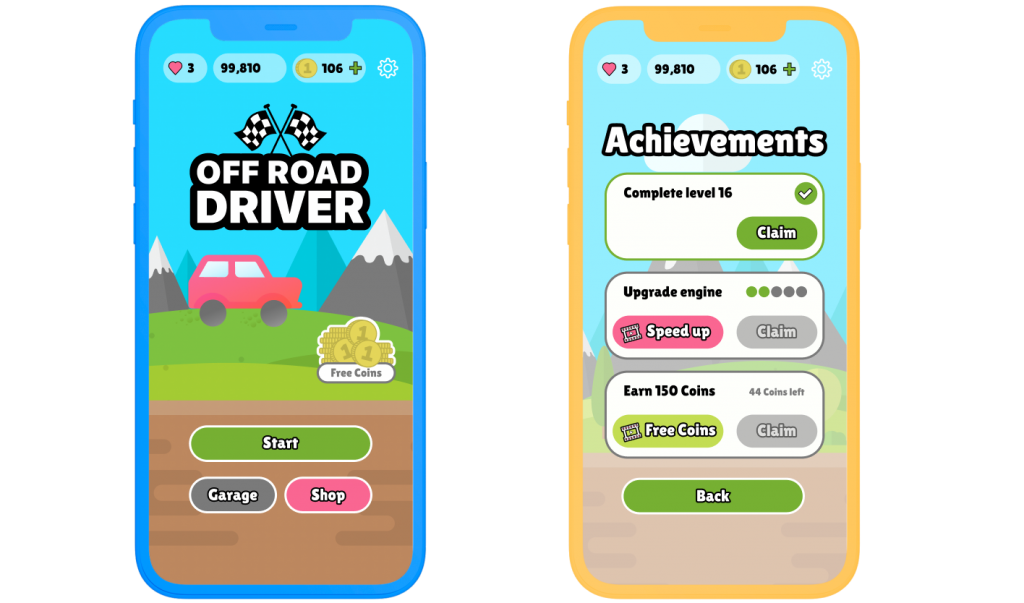If you’re looking to improve revenue, your ad placement strategy is a great place to start. Every aspect of ads - placements, reward amount, frequency, and more - influences user engagement, which dictates earnings. Tweaking an ad placement is a strategic process, but A/B testing makes it more straightforward - any change to ads can be tested and evaluated before deciding if it’s worth any potential risk.
However, before you can A/B test anything, you need first to know the context of how your business is performing according to KPIs. These KPIs provide a necessary story about every aspect of your game performance, including the effectiveness of a your ad strategy.
Here are the 3 KPIs you should monitor and suggestions for ad placement A/B tests to run.
KPI #1: Engagement rate
The first KPI to pay attention to is engagement rate. Let’s explore what you can decode from both high and low engagement rate and how this can inform which A/B tests to utilize. As a reminder, engagement rate is the percentage of users who engaged with the ad unit - how many users saw an ad out of all daily users.
Low engagement rate
Rewarded videos
For rewarded videos, low engagement rate can signify a couple of issues. First, it’s possible that players never noticed the traffic driver. This can be solved by attracting more players to the button - you can A/B test different traffic driver positions and colors, different buttons, or just general designs in the area. Generally, if you want your button to be noticed, it needs to be different from all the other buttons in the game. For example, using contrast can help the players more easily identify the button with their eyes.
Second, perhaps the user simply didn't see the value in the reward. It’s not easy to predict how many resources a user will need at a certain point in the game, so it’s tough to accurately predict what specific amount of reward would excite users. In this case, it’s best to A/B test different kinds of rewards (e.g. different currency) or the actual reward amount. Here, it’s critical to know your players and what they want during their game process - it tells you what rewards are most exciting at any given moment.

Interstitials
If your interstitials have a low engagement rate, perhaps players aren’t reaching the point where the interstitial is starting. For example, let’s say that a game sets interstitials to pop up on the main page, but doesn’t present this page until after the player completes the first level - if many players get frustrated and log out before completing this level, they would miss the interstitial completely. Here, you can A/B test placing interstitials in a more populated location based on players’ behaviors, such as between levels, when users are most eager to continue playing.
Another explanation for a low engagement rate might be that players are being segmented out and don’t see as many interstitials as other players in different segments. If you are segmenting out paying players from interstitials, do so wisely. For example, if your game has a subscription model, players shouldn’t be seeing interstitials unless the subscription runs out.
High engagement rate
Rewarded videos
It’s not just low KPIs that tell a story - you can learn and optimize performance from a high engagement rate too. If engagement is high for rewarded videos, you can assume that these placements were a great fit for players. You should continue to A/B test placements with similar value and currency in different parts of the game. However, if you’re ever adjusting currency, it always needs to work with the game economy - for example, if you’re increasing reward, you need to adjust the game economy to give less of this currency in the rest of the game.

Interstitials
Positive engagement rate for interstitials reflects that many players are viewing interstitials. This is great, but it’s worth considering that too many interstitials might overwhelm users, potentially decreasing the amount of daily active users. It’s best to A/B test placing interstitials based on player behavior (e.g. noticing which pages/areas they most often visit) and increasing capping/decreasing pacing - all while being mindful of playerretention.
KPI #2: Usage rate
Next, let’s understand what causes low and high usage rate (how many ads an engaged user is seeing per day) and how you can optimize this information with A/B testing.
Low usage rate
Rewarded videos
Low usage rate for rewarded videos indicates that not many users are engaging with ads - likely players don't recognize the value in the reward, or maybe just don’t see its value in the moment. Try A/B testing a different kind of reward to switch things up or reward with a different value to see whether players might be more interested.
Interstitials
With interstitials, a low usage rate hints that the user is simply not being shown enough interstitials. This might be an indication that interstitials should be placed in the game more often. You can A/B test this to determine whether decreasing pacing (showing interstitials on a more consistent basis) can increase usage rate without sacrificing the player’s user experience or engagement with the game.
High usage rate
Rewarded videos
If you’re seeing high usage rates with rewarded videos, that’s great! It seems like players are enjoying the placement of the video to the maximum amount. Why not use A/B testing to test the limits? You can test decreasing the pacing to see whether these users would still be as engaged if they were being offered fewer rewards. This way, players could also be watching more videos, and in turn increase ad impressions. Again, it’s essential to be conscious of the game economy - any increase in rewards must be balanced to ensure it keeps its value.

Interstitials
Similar to rewarded videos, high usage rates with interstitials reflect that a large amount of players are viewing interstitials, and the ad placement is high quality. A/B testing other placements and capping/pacing to increase exposure to interstitials will ensure that you’re finding the right balance - players should regularly see ads but shouldn’t be overwhelmed in the process.
KPI #3: Impressions per DAU
Let’s also explore the meaning of impressions per DAU, both low and high, and how this should factor into A/B testing decisions. As a reminder, impressions per DAU is the average impressions per user on a given day - the total number of impressions divided by the number of active users.
Low impressions per DAU
Rewarded videos
If you’re finding low impressions per DAU for rewarded videos, check the usage rate - if it’s still high, it’s likely that players aren’t noticing your traffic driver (and the only ones finding value in it are the ones who notice it). You should A/B test making the traffic driver pop more - for example, making the button the only animated part of a page automatically makes players notice it and engage with it more often. When impressions per DAU are low, exposure is crucial - this includes placing drivers in popular locations and pages, and locations that are easy to find and click.
Interstitials
With interstitials, low impressions per DAU collects many of the similar problems from low engagement and low usage rate. It implies that players aren’t visiting places in the game with the interstitial, might be segmented out, and generally aren’t seeing enough interstitials. Like the other KPIs, A/B testing recommendations include: placing interstitials in more popular locations, segmenting more carefully, and decreasing pacing so players can see more interstitials.
High impressions per DAU
Rewarded videos
High impressions per DAU for rewarded videos, like high usage rate, indicates that the ad placement is a great fit for players. Similarly to high usage rate, it’s best to first A/B test increasing the capping and decreasing pacing to see whether you can show players more ads and retain their engagement.
Interstitials
High impressions per DAU is confirmation of great interstitial placements. It’s recommended to A/B test ad placements and modifying capping and pacing, but it's important to keep in mind that high amounts of interstitials can cause churn - lowering the amount of daily active users. This KPI captures all players, so you should be mindful that your A/B testing isn’t sacrificing retention.
Informed by these KPIs and many more, A/B testing turns data into an actionable plan, so it’s essential to know how to use and utilize it for your business. In fact, ironSource’s A/B test tool has simplified this process, so now you can split users into two groups to test ad monetization strategies - all within a few clicks. Check out more.




